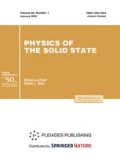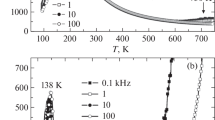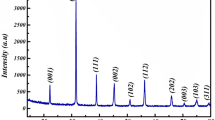Abstract
The temperature dependence of the permittivity ε of PbWO4 crystals is studied in the range T = 290–550 K at a frequency of 1 kHz. The ε(T) dependences measured on heating and cooling are different. On heating, groups of narrow maxima at 290–330 K and 330–400 K are observed in the ε(T) curves. The first group of peaks is dominant. High-temperature polarization produces an additional broad peak in the ε (T) curve at 400 K. A linear ε(T) dependence is observed in the range 400–470 K. Above 470 K, the variation in ε(T) closely follows an exponential law. Restoring relaxation of ε in the range 25–30 at 290 K after high-temperature sample heating proceeds exponentially in a few stages. The features of ε(T) curves are determined by the dipole polarization and the hopping mechanism of charge exchange between complex dipole associates. Such structural defects may be pairs of doubly charged lead and oxygen vacancies (diplons). These defects also form a basis for more complicated defect complexes with localized holes (or electrons) at the corresponding vacancies.
Similar content being viewed by others
References
M. Nikl, Phys. Status Solidi A 178(2), 595 (2000).
V. N. Shevchuk and I. V. Kayun, Fiz. Tverd. Tela (St. Petersburg) 45(10), 1807 (2003) [Phys. Solid State 45, 1898 (2003)].
V. N. Shevchuk and I. V. Kayun, Funct. Mater. 10(2), 229 (2003).
V. N. Shevchuk and I. V. Kayun, Visn. L’viv. Derzh. Univ., Ser. Fiz. 35, 60 (2002).
J. A. Groenink and H. Binsma, J. Solid State Chem. 29(2), 227 (1979).
B. Han, X. Feng, G. Hu, P. Wang, and Z. Yin, J. Appl. Phys. 84(5), 2831 (1998).
H. Huang, W. Li, X. Feng, and P. Wang, Phys. Status Solidi A 187(2), 563 (2001).
W.-S. Li, T.-B. Tang, H.-W. Huang, and X.-Q. Feng, Jpn. J. Appl. Phys., Part 1 40(12), 6893 (2001).
H.-W. Huang, Z.-G. Ye, M. Dong, W.-L. Zhu, and X.-Q. Feng, Jpn. J. Appl. Phys., Part 2 41(6B), L713 (2002).
H.-W. Huang, X. Feng, T.-B. Tang, M. Dong, and Z.-G. Ye, Phys. Status Solidi A 196(2), R7 (2003).
W. Li, T.-B. Tang, and X. Feng, J. Appl. Phys. 87(11), 7692 (2000).
S. K. Arora and T. Mathew, Phys. Status Solidi A 116(1), 405 (1989).
O. V. Ivanov, A. P. Nakhodnova, and V. N. Krivobok, Zh. Neorg. Khim. 27(3), 587 (1982).
A. A. Potapov, Dielectric Method for Studying Substances (Irkut. Gos. Univ., Irkutsk, 1990) [in Russian].
A. E. Nosenko and V. N. Shevchuk, Fiz. Tverd. Tela (St. Petersburg) 39(5), 871 (1997) [Phys. Solid State 39, 775 (1997)].
M. V. Mokhosoev and Zh. G. Bazarova, Complex Oxides of Molybdenum and Tungsten with Elements of Groups I–IV (Nauka, Moscow, 1990) [in Russian].
Y. R. Reddy and L. Sirdeshmukh, Phys. Status Solidi A 103(2), K157 (1987).
J. Bourgoin and M. Lannoo, Point Defects in Semiconductors, Vol. 2: Experimental Aspects (Springer, New York, 1983; Mir, Moscow, 1985).
A. B. Lidiard, Ionic Conductivity (Springer, Berlin, 1957; Inostrannaya Literatura, Moscow, 1963).
E. A. Ukshe and N. G. Bukun, Solid Electrolytes (Nauka, Moscow, 1977) [in Russian].
M. Nikl, K. Nitsch, S. Baccaro, A. Cecilia, M. Montecchi, B. Borgia, Dafinei, I. M. Diemoz, M. Martini, E. Rosetta, G. Spinolo, A. Vedda, M. Kobayashi, M. Ishii, Y. Usuki, O. Yarolimek, and P. Reiche, J. Appl. Phys. 82(11), 5758 (1997).
Q. Zhang, T. Liu, J. Chen, and X. Feng, Phys. Rev. B 68, 064101 (2003).
V. V. Laguta, M. Martini, A. Vedda, E. Rosetta, M. Nikl, E. Mihokova, J. Rosa, and Y. Usuki, Phys. Rev. B 67, 205102 (2003).
Y. B. Abraham, A. W. Holzwarth, R. T. Williams, G. E. Matthews, and A. R. Tackett, Phys. Rev. B 64, 245109 (2001).
A. K. Jonscher, Universal Relaxation Law. Dielectric Relaxation in Solids (Chelsea Dielectric, London, 1996).
T. V. Panchenko, L. M. Karpova, and V. M. Duda, Fiz. Tverd. Tela (St. Petersburg) 42(4), 671 (2000) [Phys. Solid State 42, 689 (2000)].
P. V. Zhukovskii, Ya. Partyka, P. Vengerék, Yu. Shostak, Yu. Sidorenko, and A. Rodzik, Fiz. Tekh. Poluprovodn. (St. Petersburg) 34(10), 1174 (2000) [Semiconductors 34, 1124 (2000)].
L. E. Soshnikov, V. M. Trukhan, and S. F. Marenkin, Neorg. Mater. 39(4), 395 (2003).
A. E. Nosenko and V. N. Shevchuk, Radiat. Eff. Defects Solids 134(1–4), 251 (1995).
Author information
Authors and Affiliations
Additional information
__________
Translated from Fizika Tverdogo Tela, Vol. 47, No. 4, 2005, pp. 608–613.
Original Russian Text Copyright © 2005 by Shevchuk, Kayun.
Rights and permissions
About this article
Cite this article
Shevchuk, V.N., Kayun, I.V. Temperature dependence of the permittivity of PbWO4 crystals in the range 290–550 K. Phys. Solid State 47, 632–637 (2005). https://doi.org/10.1134/1.1913972
Received:
Accepted:
Issue Date:
DOI: https://doi.org/10.1134/1.1913972




